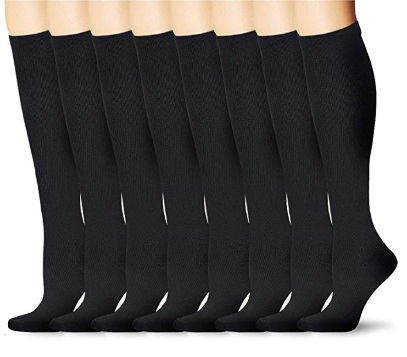
Finding a great pair of 15 mmHg to 20 mmHg, 20 mmHg to 25 mmHg, 25 mmHg to 30 mmHg, or 20 mmHg to 30 mmHg high ribbed pressure hose for larger legs can be challenging. There are many styles and brands, but not much guidance. In this article, we’ll change that by providing information on how knee-high or thigh-high ribbed pressure hose works, general measurement guidelines, and top-rated wide-calf compression socks.
For people with cone-shaped legs, fitting can be particularly tricky, as hose tends to slide more easily and roll down their calves. Fortunately, solutions for this exist, and we’ll discuss them below.
Large or Thick Legs
A glance at Amazon’s top results shows that many manufacturers make wide-calf style socks for customers with larger legs. The hose are described as being very soft and easy to wear. They also offer a variety of compression levels. That said, most of them are black or flesh-toned and lack personality.
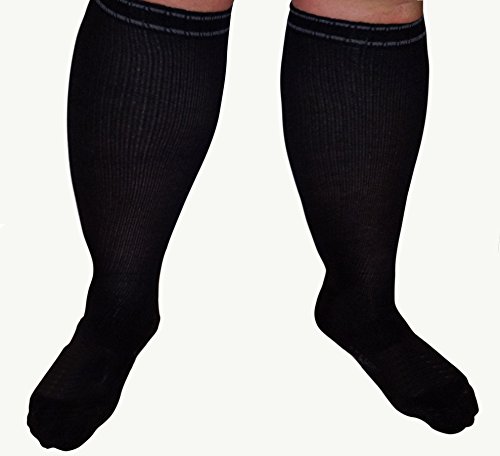
As with most garments, knee-high or thigh-high 15 mmHg to 20 mmHg, 20 mmHg to 25 mmHg, 25 mmHg to 30 mmHg, or 20 mmHg to 30 mmHg ribbed pressure hose are available in many different sizes. Some go as high as 4 or 5-X. The top-selling colors are black and white, and the top-selling compression level is 20-30 mmHG.
If you’re unsure what size you are, don’t worry. It’s easy enough to find out.
Most brands provide a size chart. To find your size, you just need to measure the circumference and length of your legs at certain, specified points. This is best done with a flexible, vinyl tape measurer meant for measuring the body, but any measuring tape should do.
Of the many types of knee-highs or thigh-high 15 mmHg to 20 mmHg, 20 mmHg to 25 mmHg, 25 mmHg to 30 mmHg, or 20 mmHg to 30 mmHg ribbed pressure hose available, the largest are found in the Sigvaris Secure line.
They are used to help people with severe vascular disease or edema. These conditions aren’t helped much by thinner fabrics like sheer or microfiber. Sigvaris Secure 15 mmHg to 20 mmHg, 20 mmHg to 25 mmHg, 25 mmHg to 30 mmHg, or 20 mmHg to 30 mmHg high ribbed compression socks are comparatively stronger than other brands, and yet the material is still breathable and relatively easy to wear.
Sigvaris Secure is available in 20-30, 30-40, and 40-50 mmHg. They’re also a great solution for patients with these serious and severe conditions. For people with moderate swelling and less severe vascular issues, however, they may be uncomfortable, needlessly restricting, and tight.
ComproGear offers knee-high and thigh-high ribbed pressure hose in the 20 mmHg to 30 mmHg and 30 mmHg to 40 mmHg ranges. The X-Large size can fit calves up to 28″ around, and they come in short and long styles. They are both softer and stretchier than the Sigvaris Secure line, offering a more comfortable fit at a more affordable price.
ComproGear’s 20 mmHg – 30 mmHg knee-high ribbed pressure hose are also available in wide-calf sizes, fitting a calf circumference of up to 26 inches and an ankle of up to 15.5 inches.
Feedback from customers shows that, when properly sized, the ComproGear hose fits bigger calves perfectly. They’re designed to provide the needed support without being too tight. This makes them comfortable and easy to wear for a full day of walking, sitting, or a combination of the two.
The extra-wide calf sizes are available in plus and comfort sizes for men. They vary by size, so be sure to check your specific measurements against the size chart when making your purchase.
Cone-Shaped Legs
Regular hose are either made with little to no form or are designed to fit the legs of an athletic 20-year-old model. In the latter case, the top of the knee-high socks is supported by the contour of the leg below the knee. Many people don’t have the legs of a 20-year-old model. In fact, many of us have cone-shaped legs, meaning that measurements taken progressively down the leg will always yield smaller numbers. This is particularly true regarding the juncture between the knee and the calf, as no part of the calf is smaller than the knee.
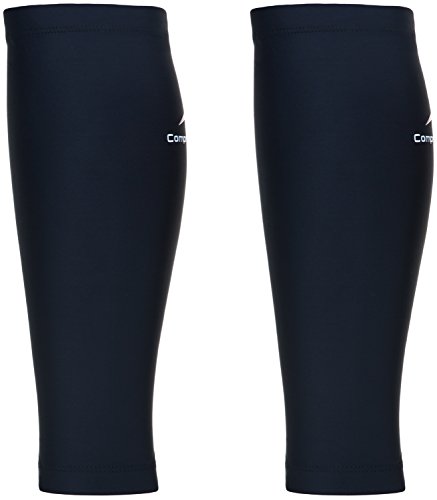
When it comes to buying socks and stockings, this is not an ideal shape because it’s not designed for cone-shaped legs.
Without the contour below the knee that most socks are designed to have, most pressure hose will quickly slip or roll down the calf. At best, this means that your calf isn’t getting the benefit you’d hoped. At worst, it can mean that all the compression that was meant to be spread over your entire calf is instead focused on a smaller area. This, of course, can create tightness and discomfort.
To solve this problem, ComproGear has designed their knee-high and thigh-high 20 mmHg to 30 mmHg and 30 mmHg to 40 mmHg ribbed pressure hose with silicone top bands. This is the same material used by world-class cyclists to keep their shorts from bunching on long, rigorous rides. Silicone bands provide a gentle, non-abrasive means of supporting pressure hose and keeping them from sliding or rolling.
Silicone top bands are available from ComproGear in knee-high sizes 15-20, 20-30, and 20-30 mmHg.
How Do Knee-High or Thigh- High 20 to 30 mmHg and 30 to 40 mmHg Compression Socks Work?
Our bodies use pressure to get fluids -including blood- from our feet to our hearts. In a healthy body, the walls of the veins are strong enough to support this pressure. As we age, get injured, or suffer illness, however, the strength of these vessels can weaken. When this happens, our bodies struggle to force fluid from the lowest parts of our bodies back to our heart. This can create a build-up of fluid, which can cause many medical problems.
Knee-high or thigh-high 15 mmHg to 20 mmHg, 20 mmHg to 25 mmHg, 25 mmHg to 30 mmHg, or 20 mmHg to 30 mmHg ribbed pressure hose and stockings work by helping to support the natural pressure in our veins, squeezing blood and other fluids from our legs up to our heart. By applying gentle compression to your legs and ankles, regular blood flow can be maintained. This helps reduce swelling and pain in your legs and ankles.
When Should You Wear Compression Socks?
You should always check with your doctor or physical therapist for medical advice. Usually, when knee-high or thigh-high 15 mmHg to 20 mmHg, 20 mmHg to 25 mmHg, 25 mmHg to 30 mmHg, or 20 mmHg to 30 mmHg ribbed compression socks are recommended, they’re to be worn throughout the day but not while sleeping or lying down. This is because blood and other fluids don’t tend to pool in our feet when we’re lying down. However, this advice can vary from person to person and depends on the condition. Another consideration is whether compression is needed on one or both legs.
In many cases, it is advised to put the stockings on first thing in the morning, before standing up. This will allow the 15 mmHg to 20 mmHg, 20 mmHg to 25 mmHg, 25 mmHg to 30 mmHg, or 20 mmHg to 30 mmHg high-ribbed compression hose to work before any fluids have a chance to build up in the lower legs.
How to Put on Pressure Hose
The 15 mmHg to 20 mmHg, 20 mmHg to 25 mmHg, 25 mmHg to 30 mmHg, or 20 mmHg to 30 mmHg high-ribbed compression socks (and especially taller stockings with high compression) can be difficult to put on. They can feel tight at first, and challenging to get comfortable with if you’re not used to them.

Try the following tips while using knee-high or thigh-high 15 mmHg to 20 mmHg, 20 mmHg to 25 mmHg, 25 mmHg to 30 mmHg, or 20 mmHg to 30 mmHg ribbed wide-calf compression socks:
- Make sure your skin is dry and free of lotion.
- Apply cornstarch or baby powder to your legs.
- Use rubber gloves if you need an extra grip on the stockings.
- Avoid bunching them like you might regular socks.
- Hold the toe of the sock from the inside and turn the sock inside out to reach the heel.
- Ensure the sock is in place on your foot and heel.
- Pull the stockings up to their designed height.
- Smooth out any wrinkles or folds, and you’re done! It’s that simple!
Which Type of Compression Stockings Should You Use?

Wide-calf 15 mmHg to 20 mmHg, 20 mmHg to 25 mmHg, 25 mmHg to 30 mmHg, or 20 mmHg to 30 mmHg high-ribbed compression socks are available in various sizes, lengths, and levels of tightness. The proper style is determined by your needs – only you and your medical providers know where you need compression! To find the proper size, fit, and feel, measure the circumference of your ankle, calf, and thigh, as well as the length of your upper and lower leg. Then, compare your measurements against our guide. You can also consult your doctor.
Related Topics about Compression Socks
- Sock Soothers
- Medical Compression Socks
- Compression Sleeves for Legs
- Best Compression Socks for Swelling
- Compression Socks for Men
- Wide Calf Compression Socks
- Best Compression Socks for Swelling
- Toeless Compression Socks
- Can You Wear Compression Stockings 24 Hours a Day
- Do Compression Socks Help Gout
- Easy To Put On Compression Socks for Elderly
Support Strengths of Ribbed Pressure Hose
The right amount of compression is determined by your needs and conditions. Compression is measured in millimeters of mercury (mmHg) in ranges from 8-15 mmHg to 30-40 mmHg.
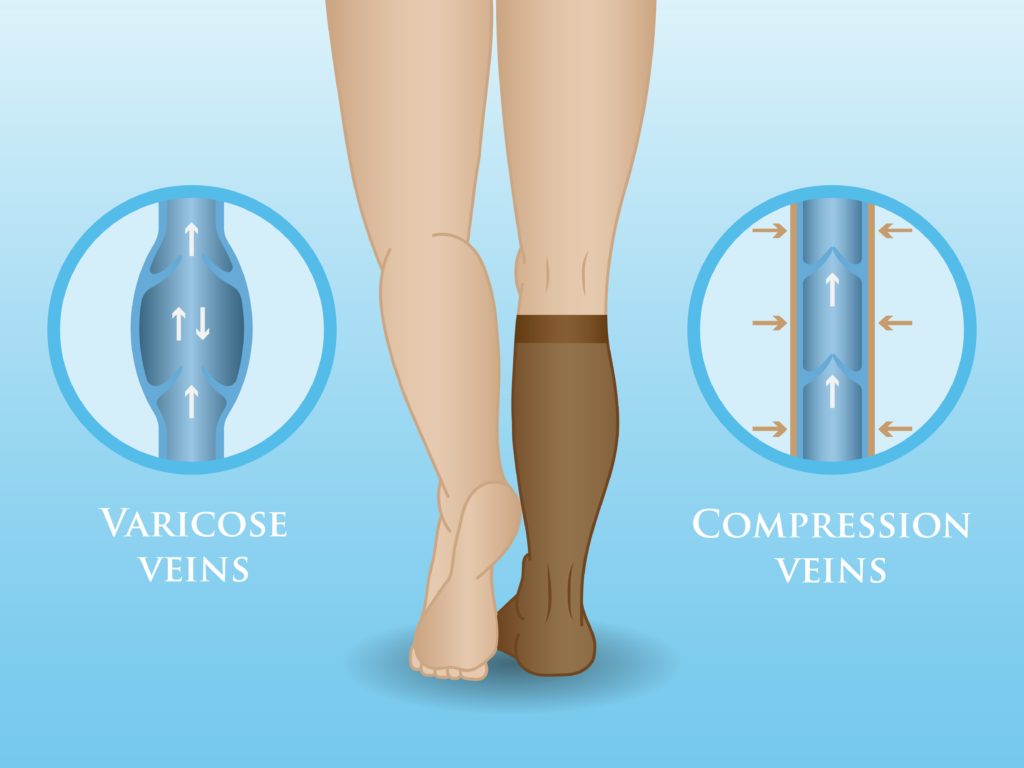
8 mmHg to 20 mmHg, 15 mmHg to 20 mmHg, and 20 mmHg to 25 mmHg ribbed hose variations can be used for a wide variety of reasons, including support while running or working out. While the compression in these socks is only light to moderate, it’s always recommended to have your needs monitored by a doctor or medical practitioner.
For people with varicose veins, 20-30 mmHg is an excellent compression level for managing mild discomfort. You can choose a higher compression level if the condition is more severe.
20-30 mmHg Compression Socks

20-30 mmHg is the most frequently prescribed compression level. It is used to treat a variety of mild to moderate conditions, such as edema, varicose veins, and deep vein thrombosis, and is usually prescribed post-sclerotherapy. The 15 mmHg to 20 mmHg, 20 mmHg to 25 mmHg, 25 mmHg to 30 mmHg, or 20 mmHg to 30 mmHg high-ribbed compression socks include knee-high, thigh-high, and waist-high styles. These styles are also available in various colors and designs so that you don’t have to sacrifice fashion when wearing the socks.
20 mmHg – 30 mmHg pressure hose are referred to as “Class I,” or firm compression. They help promote venous blood flow for people who suffer from venous disorders, both preventing and relieving painful symptoms.
Strength of Firm 20-30 mmHg Socks
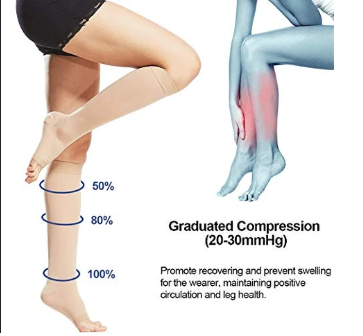
20-30 mmHg are recommended for:
- Pronounced varicose veins
- Spider veins
- Edema
- DVT
- Post-surgical recovery
- Swelling in ankles, calves, or feet
- Enlarged, bulging veins
- Pregnant or nursing women
- Travel
- Tired, aching, or heavy legs
- Muscle recovery after cardio and exercise
Features & Benefits
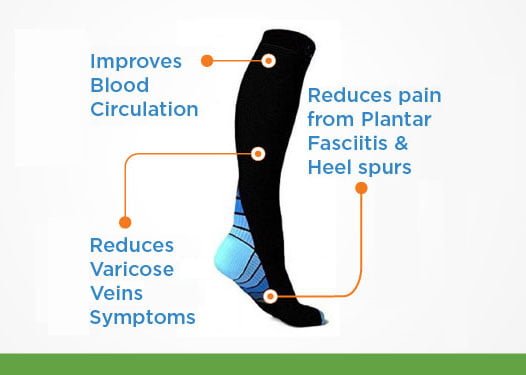
- The durable, opaque material is designed in a classic medical shape and style.
- They have a soft top, which provides a comfort band and a flexible fit.
- There is a defined knit-In heel and a reinforced heel pocket, which extends durability and promotes comfort and a good fit.
- The design considers toe comfort. These socks will not overly compress the toes, which reduces the chances of excess compression and chaffing on sensitive feet.
- Your ankles will benefit from the graduated compression.
This technology allows the compression to reduce gradually up the leg, which allows for smoother circulation and keeps the muscles oxygenated and energized.
The Best Compression Socks For Understanding Blood Flow
Before we discuss the technology behind knee-high or thigh-high 15 mmHg to 20 mmHg, 20 mmHg to 25 mmHg, 25 mmHg to 30 mmHg, or 20 mmHg to 30 mmHg ribbed compression socks, we need to better explain the basics. We’re going to cover how blood flow works in our bodies and how compression socks help when regular socks don’t, among other things.
Our heart is a kind of pump. It pushes blood throughout our arteries. The blood is brought back to the heart through our veins. It’s this circulation that allows oxygen and other nutrients to get to our muscles, organs, and other parts of the body.
Poor circulation in our lower extremities can keep blood from reaching the muscles in our feet and calves by standing in the way of fresh, oxygen-rich blood. But it also deprives the rest of the body by cutting down on the amount of blood that can carry oxygen to our cells. When our cells don’t get enough oxygen, they don’t function as well. Our muscles tire faster, and even our brains – which also need oxygen – can feel sluggish.
By helping blood move up from our lower extremities, knee-high or thigh-high 15 mmHg to 20 mmHg, 20 mmHg to 25 mmHg, 25 mmHg to 30 mmHg, or 20 mmHg to 30 mmHg ribbed compression socks can help us feel more energized and focused. Better circulation means more oxygen getting where it needs to be.
What Are Other Benefits Of Compression Hose?
Knee-high or thigh-high 15 mmHg to 20 mmHg, 20 mmHg to 25 mmHg, 25 mmHg to 30 mmHg, or 20 mmHg to 30 mmHg ribbed compression socks provide many benefits. Where you see the most benefits and to what degree depends on your needs and lifestyle.
Extended Oxygen Circulation
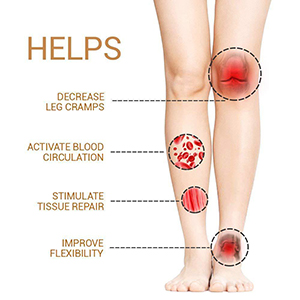
As we discussed above, good circulation means improved muscle health. Even fit athletes can benefit from from 15 mmHg to 20 mmHg, 20 mmHg to 25 mmHg, 25 mmHg to 30 mmHg, or 20 mmHg to 30 mmHg high-ribbed compression socks. These socks move oxygen-depleted blood more quickly away from the feet and calves, so the entire body is better able to sustain and recover from a hard workout.
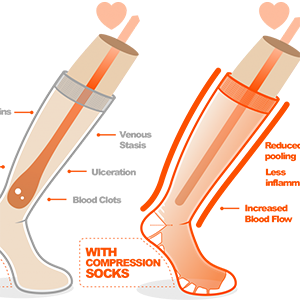
Pressure hose delivers these benefits by providing balanced compression. The socks are tighter at the bottom and looser at the top, which allows an optimal flow of blood and nutrients.
Gravity pulls blood to the feet and tries to keep it there. The body lacks a direct mechanism to pull blood back to the heart. Pressure hose are especially designed to help your veins do their job by maintaining enough pressure to literally squeeze the blood up your body. The improved circulation – even in healthy legs – helps the heart get fresh, oxygenated blood where it needs to be.
Reduced Lactic Acid
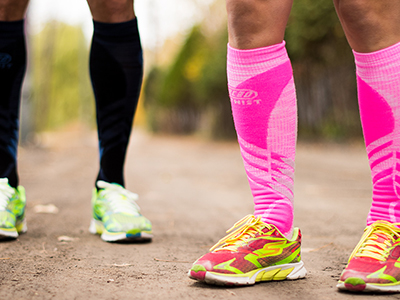
The men’s wide-calf 15 mmHg to 20 mmHg, 20 mmHg to 25 mmHg, 25 mmHg to 30 mmHg, or 20 mmHg to 30 mmHg high-ribbed compression socks can also prevent muscle soreness. Muscle contractions are a chemical process. And, as we might remember from high school chemistry, chemical reactions produce waste. In muscles, this waste is called “lactic acid.”
By increasing blood flow, the body becomes better able to flush lactic acid away from muscles during exercise, which allows the muscles to maintain an appropriate pH. This enables them to contract when they should, and to stop contracting when you need them to.
If the lactic acids stays in your muscles after your workout, it will contribute to the feeling of soreness over the next several days. Unsurprisingly, good circulation – which pressure hose helps – will help flush these toxins out of your muscles. This allows them to heal quickly so you can get back to training faster.
Compression Socks Can Prevent Cramps and Swelling
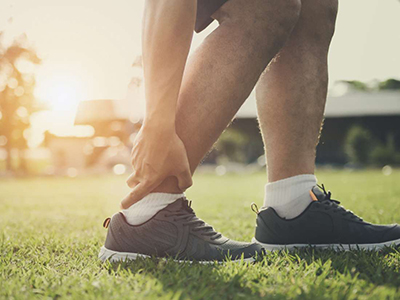
During long cardio sessions such as biking or running, blood tends to pool in the feet. Compression, as you probably know by now, reduces this. Wearing knee-high ribbed pressure hose during these activities will help decrease strain by aiding circulation and helping oxygen-rich blood get where it needs to be.
Pressure hose for running and cycling will help control swelling in your feet, calves, and legs. Since these socks press around these areas, they counteract gravity’s tendency to force fluids to pool.
Do Compression Socks for Running Actually Work?
Running clubs everywhere have begun using and recommending pressure hose, praising their benefits and their ability to make runs feel easier.
How does this hypothesis hold up? Could compression treatment truly take your workout to the next level?
That depends on who you ask.
Looking at the science behind the issue reveals some surprising results.
The study “Compression Socks and Functional Recovery Following Marathon Running: a Randomized Controlled Trial” had positive findings.
However, other studies have had different results.
Take this one, for example:
In the study “Viability of Compression Socks to Enhance Recovery in Distance Athletes,” distributed by Horizon Research Publishing Company, sprinters wore pressure hose during a two-hour run and kept the socks on for eight hours after. The results were not exactly positive; scientists saw inconsequential changes in muscle irritation and failed to discover anything connecting pressure hose and improved performance.
It should be noted that studies are often done on collegiate athletes, because they’re so readily available on campuses. Not surprisingly, their results don’t often bear out for the general population. After all, even the fittest 40-year-old is likely to have more circulatory problems than a 22-year-old college sprinter.
Lower Leg Compression Sleeves:
If you feel sore after exercise or have stopped making gains, then using compression gear to help your circulation during and after exercise has been shown to have benefits for all but elite-level athletes.
The Effects of Compression Socks
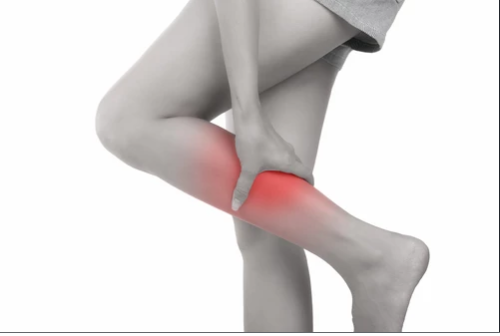
- In the hemodynamic impact, compression socks:
• Increase venous blood flow
• Decrease venous blood volume
• Reduce reflux in ailing, shallow, and additionally profound veins
• Reduce pathologically raised venous weights
2. The Effect of compression socks on the tissue:
- Reduces raised edema in the tissue
- Increases the waste of substances
- Reduces irritation
- Sustains fixing forms
- Improves the development of ligaments and joints
3. Directions for wear:
• Grab the heel pocket and pull the socks back to front up to the heel.
• Pull over foot until the impact point is situated equally over legs.
• Gently slide the hose up to the leg and smooth out the wrinkles.
Note: Do not crease over the band or allow the sock to roll.
4. Care directions:
Hand wash with a gentle cleanser in tepid water. Do not wring. Pat dry with a towel.
The Bottom Line:
When buying pressure hose or stockings, take measurements early in the morning before swelling has a chance to build up in the legs. If the measurements are taken later after swelling occurs, you may select the wrong sized product. If this happens, the effect of the compression will not work for you.
20-30 mmHg: The most frequently recommended compression level, 20-30 mmHg pressure hose provides compression that can treat an assortment of mild to moderate conditions. This level can help varicose veins, edema, profound vein thrombosis, and post-sclerotherapy.
Before wearing pressure hose of 20-30mmHg (firm compression) or more, consult your doctor to see whether it’s right for you. They can discuss with you what grade you should consider, as well as styles and heights.
This page last updated November 5, 2022
